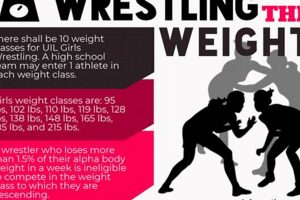State high school athletic associations typically establish specific weight categories for wrestlers to ensure fair competition. These categories group athletes of similar size and strength, promoting safety and a more balanced competitive landscape. For the 2022-2023 academic year, most states adhered to the 14 weight classes established by the National Federation of State High School Associations (NFHS). These classes range from 106 pounds to 285 pounds, providing a structured system accommodating diverse physiques.
The categorization by weight is fundamental to the integrity of scholastic wrestling. It minimizes the risk of mismatch and injury, allowing skill and technique to become the deciding factors in a bout rather than sheer size or power. This structure has evolved over time, reflecting a growing understanding of athlete safety and competitive equity. Proper weight management within these established parameters is vital for both individual and team success, fostering discipline and a focus on healthy practices within the sport.
This article will delve into the specifics of each weight class, exploring the challenges and opportunities presented to wrestlers competing at different levels. Furthermore, it will address effective strategies for managing weight safely and strategically, along with the overall significance of weight classes in shaping the high school wrestling experience.
Successfully navigating weight classes is crucial for wrestlers seeking to maximize their competitive potential while prioritizing health and well-being. These tips offer guidance for athletes, coaches, and parents.
Tip 1: Consult with a Certified Nutritionist or Registered Dietitian: Proper nutrition is paramount for achieving and maintaining a healthy wrestling weight. Professional guidance can personalize dietary plans to support training demands without compromising an athlete’s health.
Tip 2: Implement a Gradual Weight Management Strategy: Rapid weight loss or gain can negatively impact performance and overall health. Slow, consistent adjustments are more sustainable and less detrimental.
Tip 3: Prioritize Hydration: Proper hydration is essential for optimal athletic performance and overall well-being. Dehydration can impair cognitive function and increase the risk of injury.
Tip 4: Focus on Strength and Conditioning: Enhancing strength and conditioning within one’s weight class can provide a significant competitive advantage. This approach emphasizes athleticism rather than solely manipulating body weight.
Tip 5: Understand the Rules and Regulations: Familiarization with the specific rules and regulations governing weight classes within the respective state athletic association is critical for compliance and avoiding penalties.
Tip 6: Monitor Weight Regularly but Avoid Obsession: Regular monitoring allows for adjustments to training and diet. However, obsessive focus on the scale can be counterproductive and detrimental to mental health.
Tip 7: Emphasize Long-Term Athletic Development: Weight management should complement long-term athletic goals, not hinder them. Sustainable practices promote continued growth and success throughout a wrestler’s career.
By adhering to these principles, wrestlers can optimize their performance while promoting a healthy and sustainable approach to weight management. This framework fosters both individual and team success while emphasizing the importance of athlete well-being.
These insights into effective weight management strategies contribute significantly to a comprehensive understanding of the demands and rewards of high school wrestling.
1. Competitive Equity
Competitive equity forms the cornerstone of high school wrestling’s weight class system. The presence of designated weight categories ensures fairer matchups by minimizing significant size and strength discrepancies between competitors. This system allows wrestlers to compete against opponents of similar physical attributes, placing greater emphasis on technique, strategy, and skill rather than sheer power or weight advantage. Without these established categories, heavier athletes would possess an inherent, and often insurmountable, advantage, diminishing the importance of skill development and potentially increasing the risk of injury for lighter competitors. A 106-pound wrestler facing a 138-pound opponent, for example, would be at a significant disadvantage, irrespective of skill level. Weight classes level the playing field, fostering a more balanced and engaging competitive environment.
This emphasis on competitive equity has far-reaching implications. It encourages participation by creating opportunities for athletes of all sizes to excel. Furthermore, it fosters the development of well-rounded wrestlers. Athletes must focus on honing their techniques and strategic thinking, knowing that victories are earned through skill and strategy rather than simply overpowering an opponent. This focus on skill development enriches the sport, making it more engaging for both participants and spectators alike. The system also incentivizes proper weight management practices, encouraging athletes to compete at a weight appropriate for their body composition and development.
In conclusion, the pursuit of competitive equity through the implementation of weight classes is integral to the integrity and success of high school wrestling. This system safeguards athlete safety, promotes skill development, and ensures a more balanced and exciting competitive landscape. By prioritizing competitive equity, the sport cultivates an environment where dedication, strategy, and technique are rewarded, fostering both individual and collective growth within the wrestling community.
2. Safety
Safety is paramount in high school wrestling, and the weight class system plays a crucial role in mitigating risks. By grouping athletes according to weight, the system aims to reduce the potential for mismatches that could lead to injuries. The following facets illustrate the connection between weight classes and athlete safety.
- Reduced Risk of Overpowering:
Weight classes help prevent larger, stronger athletes from overpowering smaller opponents. This reduces the likelihood of injuries resulting from significant strength and weight disparities. A 113-pound wrestler competing against a 145-pound wrestler, for example, would be at a substantial disadvantage in terms of strength and leverage, increasing the risk of injury. Competing within appropriate weight categories significantly mitigates this risk.
- Minimized Impact Force Disparities:
In wrestling, takedowns and throws generate substantial force. Weight classes help ensure that athletes are competing against others with relatively similar body mass, lessening the impact force differential during these maneuvers. This reduces the potential for injuries caused by high-impact collisions between athletes of significantly different weights.
- Enhanced Competitive Fairness:
When competitors are more evenly matched physically, the focus shifts to technique and skill, fostering a safer competitive environment. Athletes can execute techniques with greater control and precision, minimizing the risk of unintended injury to themselves or their opponents. A fair match allows for a more controlled execution of techniques, minimizing the chance of uncontrolled movements that can lead to injuries.
- Encouragement of Proper Weight Management:
The weight class system discourages unhealthy weight-cutting practices. By providing a structured framework, athletes are incentivized to maintain a weight appropriate for their physique through proper nutrition and training, rather than resorting to rapid weight loss or gain, which can negatively impact both performance and long-term health.
In summary, the weight class system in high school wrestling is a critical component of athlete safety. By promoting balanced competition, minimizing force disparities, and encouraging healthy weight management, these classifications create a safer environment for wrestlers to develop their skills and compete effectively. The system ultimately serves to protect athletes while fostering a more equitable and skill-based competitive landscape.
3. Growth and Development
Proper physical and skill development is essential for success in high school wrestling. The weight class system plays a significant role in fostering this growth by providing a structured framework that encourages healthy weight management, facilitates skill development, and promotes long-term athletic progression. This structure allows wrestlers to focus on improving their abilities within a competitive context appropriate for their physical maturity and development stage.
- Biological Maturation:
Weight classes acknowledge the varying rates of biological maturation among high school athletes. A younger wrestler may not have reached the same level of physical development as an older competitor, even if they are similar in weight. Competing against others within the same weight category but of different ages allows for skill development to take precedence, recognizing that physical maturity is an ongoing process. This framework prevents premature specialization and allows for a more natural progression of physical development within each weight class.
- Skill Acquisition and Refinement:
Competing within appropriate weight classes enables wrestlers to focus on developing fundamental techniques and refining their skills without the added pressure of facing significantly larger or stronger opponents. This emphasis on technique over power allows athletes to hone their skills, build confidence, and experience success based on their abilities rather than simply their size or strength. For instance, a wrestler in the 120-pound weight class can focus on mastering takedowns and escapes against similarly sized opponents, fostering technical proficiency and strategic thinking.
- Long-Term Athletic Development:
The weight class system supports long-term athletic development by encouraging healthy weight management practices and discouraging extreme weight cutting. This emphasis on sustainable practices helps wrestlers maintain a healthy relationship with their weight and body composition, promoting both physical and mental well-being throughout their athletic careers. A wrestler who consistently employs healthy weight management strategies is more likely to experience sustained success and reduced risk of injury over time.
- Psychological Development:
Competing within a suitable weight class contributes to a wrestler’s psychological development by fostering a sense of accomplishment and building confidence. Experiencing success against similarly sized opponents reinforces the importance of skill development and strategic thinking, building self-esteem and fostering a positive mindset. This positive reinforcement cycle can have a lasting impact on a wrestler’s confidence and motivation both on and off the mat.
In conclusion, the weight class system in high school wrestling plays a vital role in supporting the growth and development of young athletes. By providing a structured pathway for competition, it fosters skill acquisition, encourages healthy weight management practices, and promotes long-term athletic and psychological development. This framework enables wrestlers to reach their full potential within a safe and competitive environment, maximizing their opportunities for success and contributing to their overall well-being.
4. Weight Management
Weight management is inextricably linked to the structure of high school wrestling weight classes. Navigating these classifications effectively requires a comprehensive understanding of proper nutrition, hydration, and training principles. Strategic weight management enables wrestlers to compete at their optimal weight class while prioritizing health and long-term athletic development. This involves adopting sustainable practices that support performance enhancement without compromising well-being.
- Nutritional Considerations:
Proper nutrition is foundational to effective weight management in wrestling. A balanced diet, tailored to meet the energy demands of training and competition, is essential. This includes consuming adequate amounts of protein for muscle recovery and growth, complex carbohydrates for sustained energy, and healthy fats for overall health. Consulting a registered dietitian or certified sports nutritionist can provide personalized guidance based on individual needs and goals. For example, a wrestler attempting to maintain weight in the 132-pound class might focus on consuming lean protein sources, whole grains, and plenty of fruits and vegetables, while avoiding processed foods and sugary drinks.
- Hydration Strategies:
Maintaining proper hydration is crucial for both performance and weight management. Dehydration can lead to decreased energy levels, impaired cognitive function, and increased risk of injury. Wrestlers should prioritize consistent fluid intake throughout the day, particularly during and after training sessions. Strategies for proper hydration include carrying a water bottle, consuming electrolyte-rich beverages, and monitoring urine color as an indicator of hydration status. Understanding the impact of hydration on performance is critical for wrestlers competing in any weight class.
- Training and Conditioning:
Effective training programs incorporate a combination of strength training, cardiovascular exercise, and wrestling-specific drills. Strength training helps build muscle mass and increase metabolism, while cardiovascular exercise improves endurance and aids in weight management. Wrestling-specific drills enhance technique and build sport-specific fitness. A well-structured training regimen supports optimal performance within a wrestler’s chosen weight class while promoting overall athletic development. For example, a wrestler in the 160-pound weight class might incorporate weightlifting to increase strength, running for cardiovascular fitness, and live wrestling practice to refine technique.
- Safe Weight Management Practices:
Sustainable weight management practices prioritize long-term health and athletic development. Extreme weight cutting, including rapid weight loss through dehydration or restrictive dieting, can negatively impact performance, compromise immune function, and pose significant health risks. Educating athletes, coaches, and parents about the dangers of unhealthy weight-cutting methods is crucial. Promoting a culture of healthy weight management within the sport ensures that wrestlers can compete safely and effectively while maintaining their well-being.
In conclusion, effective weight management is integral to success and well-being within the framework of high school wrestling weight classes. By prioritizing proper nutrition, hydration, training, and safe weight management techniques, wrestlers can optimize their performance, enhance their long-term athletic development, and contribute to a healthier and more sustainable sporting environment. These strategies are crucial not only for competitive success but also for the overall health and well-being of student-athletes.
5. NFHS Regulations
The National Federation of State High School Associations (NFHS) plays a critical role in shaping the landscape of high school wrestling across the United States. Its regulations, specifically concerning weight classes, serve as a foundational framework for ensuring fair competition and athlete safety. These regulations provide a standardized structure adopted by most state athletic associations, offering consistency and clarity regarding weight classifications, weigh-in procedures, and permissible weight loss methods. The NFHS’s influence on weight management practices, growth allowances, and overall athlete well-being is substantial. A key example of NFHS influence is the establishment of the 14 weight classes, ranging from 106 to 285 pounds, providing structure and promoting competitive balance across the nation.
One crucial area of NFHS regulation addresses permissible weight loss methods. Guidelines outlining acceptable rates of weight loss aim to discourage unhealthy and potentially dangerous weight-cutting practices. These regulations emphasize gradual weight management through proper nutrition and training, promoting long-term athletic development and athlete well-being. For instance, regulations often restrict the amount of weight a wrestler can lose per week, encouraging sustainable practices and discouraging rapid weight loss through dehydration or other harmful methods. Furthermore, NFHS regulations dictate specific hydration testing protocols during weigh-ins to ensure athletes are competing at a safe and healthy hydration level, further reinforcing the emphasis on athlete well-being. These regulations are essential for maintaining a level playing field while prioritizing the health and safety of young athletes.
Understanding NFHS regulations concerning weight classes is essential for all stakeholders involved in high school wrestlingathletes, coaches, parents, and officials. Compliance with these regulations ensures fair competition, promotes athlete safety, and fosters a healthy sporting environment. The NFHS’s role in establishing standardized rules provides a consistent framework for the sport, allowing for interstate competition and a unified approach to athlete well-being. These regulations not only shape the current landscape of high school wrestling but also contribute to the long-term development of the sport by emphasizing safety and fair play. By adhering to these guidelines, the wrestling community upholds the integrity of the sport and fosters an environment where skill, strategy, and sportsmanship are paramount.
6. Fair Matchups
Fair matchups constitute a cornerstone of high school wrestling, directly influenced by the weight class system. These classifications aim to create a competitive environment where skill and technique, rather than significant size or strength disparities, determine the outcome of a match. This principle is fundamental to the integrity of the sport, ensuring contests are decided by athleticism and strategy, not simply by inherent physical advantages. The weight class system minimizes the potential for mismatches, reducing the risk of injury and promoting a more balanced and engaging competition. A 126-pound wrestler facing an opponent in the same weight category presents a fairer contest than if pitted against a 170-pound competitor. This allows for a more nuanced display of technique and skill, enriching the sport for both participants and spectators.
The practical significance of fair matchups extends beyond individual contests. It impacts the overall development of wrestlers, encouraging a focus on skill acquisition and refinement. When athletes know they will be competing against opponents of similar size and strength, they are incentivized to develop a broader range of techniques and strategies. This focus on skill development contributes to a more dynamic and exciting sport, fostering a higher level of competition overall. Moreover, fair matchups promote greater participation. Athletes are more likely to engage in a sport where they feel they have a reasonable chance of success based on their skill level, rather than being discouraged by substantial, inherent physical disadvantages. This increased participation strengthens the sport at all levels, contributing to its continued growth and vibrancy.
In conclusion, the connection between fair matchups and the weight class system in high school wrestling is essential. This structure ensures competitive balance, promotes athlete safety, and encourages skill development. By prioritizing fair matchups, the sport fosters an environment where dedication, strategy, and technique are paramount. This focus not only benefits individual athletes but also contributes to the overall integrity and growth of high school wrestling, ensuring its continued success and appeal.
Frequently Asked Questions about High School Wrestling Weight Classes
This section addresses common inquiries regarding weight classifications in high school wrestling, providing clarity on essential aspects of the system.
Question 1: What are the standard weight classes in high school wrestling?
Most state athletic associations adhere to the 14 weight classes established by the NFHS: 106, 113, 120, 126, 132, 138, 145, 152, 160, 170, 182, 195, 220, and 285 pounds. Variations may exist depending on specific state regulations.
Question 2: How are weight classes determined?
Weight classes are designed to group wrestlers of similar size and strength, promoting fair competition and minimizing the risk of injury. The specific weight ranges within each class are established by the NFHS and adopted by most states.
Question 3: Can a wrestler change weight classes during the season?
Regulations regarding weight class changes vary by state. Generally, wrestlers can move up in weight class but face restrictions on moving down. Specific rules should be consulted within the respective state athletic association guidelines.
Question 4: What are the implications of improper weight management?
Improper weight management can lead to performance decrements, health complications, and potential disqualification from competition. Sustainable practices are crucial for both athletic success and overall well-being.
Question 5: How can wrestlers ensure they are competing at a healthy weight?
Consulting with certified nutritionists or registered dietitians, along with adhering to established weight management guidelines provided by the NFHS and state athletic associations, can help wrestlers maintain healthy weight levels.
Question 6: Where can one find specific information regarding weight class regulations for their state?
Specific weight class regulations and weigh-in procedures are available through the respective state high school athletic association websites or by contacting the association directly.
Understanding these fundamental aspects of weight classifications ensures a safer, fairer, and more enjoyable wrestling experience for all participants.
Further sections of this article will delve into specific weight class strategies and advice for wrestlers, coaches, and parents.
High School Wrestling Weight Classes 2022-2023
This exploration of high school wrestling weight classes underscores their vital role in shaping a competitive landscape that prioritizes both fairness and athlete well-being. From the establishment of standardized weight categories by the NFHS to the implementation of strategic weight management practices, the system emphasizes a balance between competitive drive and athlete health. Key aspects examined include the importance of proper nutrition, hydration, and training protocols, along with the critical role of adherence to established regulations. The examination of competitive equity, safety considerations, growth and development within weight classes, and the significant influence of NFHS guidelines provides a comprehensive overview of this crucial framework. This detailed exploration offers valuable insights for wrestlers, coaches, parents, and officials, fostering a shared understanding of the system’s importance.
The future of high school wrestling hinges on a continued commitment to refining and upholding the principles outlined within this framework. Prioritizing safe weight management practices, adhering to established regulations, and fostering a culture of competitive equity remain paramount. By embracing these core tenets, the wrestling community can ensure a sustainable and thriving environment for student-athletes to develop their skills, achieve their full potential, and contribute to the enduring legacy of this demanding yet rewarding sport.







